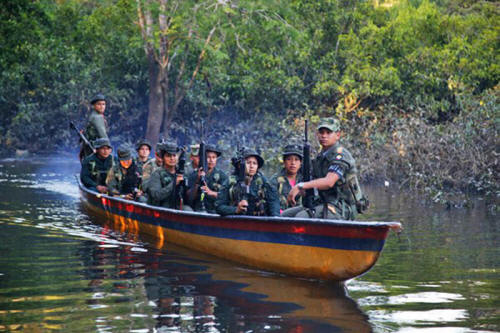|
September 06, 2016
As of Aug. 24, after 52 years of fighting and four years of negotiating, the Colombian government and the Revolutionary Armed Forces of Colombia, or FARC, have a peace accord.
The FARC will cease to be one of the
hemisphere's largest generators of violence and will transition into
a peaceful political movement.
The accord - 297 legalistic pages of plans, promises and compromises - is the product of more than 50 rounds of 15-day talks in Havana, including a marathon of closed-door sessions near the end.
The process was skillfully supported by
Norway, Cuba and other countries, as well as the assiduous efforts
of experts and subcommittees. Yet the talks may be remembered as the
easy part compared to what lies ahead.
This should happen smoothly, but it could also be the point at which we learn whether disagreements exist among the group's midlevel leadership. There may be no objections to the accord at all; the FARC is a very hierarchical organization, and many leaders spent time as negotiators in Havana.
But in July, the FARC leadership
had to expel one unit - the 200-member 1st
Front in Guaviare, just north of the Yari plains - after it voiced
its opposition.
It sets in motion a disarmament procedure, with unarmed U.N. verification and monitoring that is to last for six months. Within five days of D-Day, the FARC's 7,000 fighters, plus an unknown but probably similar number of militias and support personnel, are to begin relocating to 31 points around the country.
They will spend the following six months in these 23 village-sized "Temporary Normalization Zones" and eight remote encampments, each with U.N. observers, surrounded by a buffer zone and, beyond that, Colombian soldiers.
Within these zones, following a gradual timetable laid out in the accord, FARC members will turn in their weapons to the U.N. mission.
Guerrillas will demobilize, and those
not believed to have committed war crimes will be cleared of
sedition charges.
Will all of the FARC's members disarm, or will rogue elements refuse?
On Oct. 2, less than a week after D-Day, Colombians will vote in a plebiscite to approve or reject the accord, a step that Santos has been promising to take since 2013.
Amid the euphoria immediately following
the signing ceremony, punctuated by images of FARC fighters en route
to their concentration zones, Colombians are likely to go to the
polls and vote "yes."
Some polls show 60 percent or more Colombians inclined to vote for the accord, but a few polls show just as many "no" votes within the margin of error, or even ahead of the "yes" campaign.
Some Colombians, especially urban dwellers for whom this rural war has become little more than an outrage viewed on television, believe the government should have kept fighting to get more concessions from the FARC.
Their standard-bearer is Colombia's
previous president, Alvaro Uribe, whose eight years of
escalating military operations weakened the guerrillas on the
battlefield, leaving them more disposed to negotiate.
These aren't many, but they're still hard to swallow.
Meanwhile, Colombian social media buzzes
with complaints about the
$210 monthly stipends that ex-guerrillas will be entitled to for
two years after demobilizing, even though former members of brutal
pro-government paramilitary groups got a similar payout when they
demobilized a decade ago.
If "yes" wins, though, the disarmament, demobilization and reintegration effort will get underway.
And then the hard part truly begins, as a long list of tough questions still needs answers.
The vast majority of guerrillas will leave violence behind, but it is sadly likely that some midlevel leaders might go through the motions of demobilization, then fall back later into criminality.
To prevent that, Colombia will need a generous reintegration process that keeps an especially close eye on midlevel leaders.
This is a huge question, since a failure to seize this opportunity to govern justly in the countryside will only empower organized crime and the National Liberation Army, or ELN, a far smaller but similarly longstanding leftist guerrilla group.
There is reason to worry, as the money to do it might not be there:
The $450 million that the U.S.
government pledged for next year is roughly equal to the rest of the
world's contributions combined.
There are many obstacles ahead, but even starting to address them would be impossible without this historic breakthrough.
|


